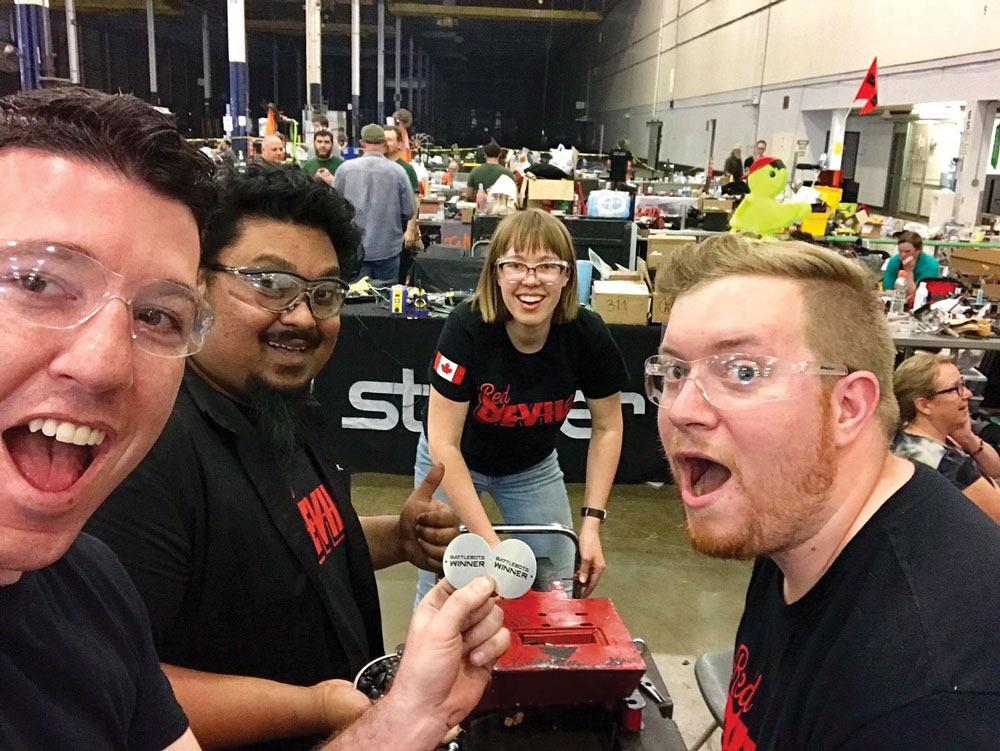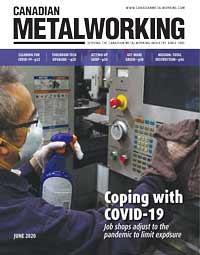- FMA
- The Fabricator
- FABTECH
- Canadian Metalworking
Mission: Total Destruction
Remote-controlled machines fight it out on “BattleBots”
- June 11, 2020
- Article
- Metalworking

The Red Devil team (left to right) Antoine Trabulsi, Ravi Baboolal, Julia Chernushevich, and Logan Prizrenac, won the first two fights in “BattleBots” Season 3. Winners get a pog for every victory.
Spinning saw blades, bludgeons, and flame-throwers are all weapons that can be built into remote-controlled robots that fight to the death during a BattleBots competition. Complete destruction or disabling of the opponent is the goal of each three-minute bout that eventually leads to the crowning of the BattleBot champion.
Teams from around the globe send battling mechanical devices into an arena fully aware that before the end of the elimination-style tournament the robots may need extensive repairs, a full rebuild, or even complete replacement.
During battle the remote-controlled robots not only need fighting ability, they need to look good for the Discovery Channel’s television cameras that record and broadcast every metal-destroying crunch in the BattleBots program. The television series highlights the design and build of each robot, bot-builder backstories, and the pursuit of the championship. If both robots are standing at the end of a bout, a panel of judges declares the winner based on points assigned in categories including aggression, control, and damage inflicted.
Canadian Metalworking talked with Canadian team members Julia Chernushevich and Antoine Trabulsi, who dubbed their contender Ferocity, and Ravi Baboolal, who created Red Devil about their obsession with building battle-worthy robots.
CM: What is the first step in getting into the competition?
Julia: You apply for a spot but you might not know until a month or two before the competition if you are going to get in. Usually you have to commit to your build before you even know if you’ll be accepted to be ready to compete.
Ravi: A “BattleBot” season might receive 500 applications that are narrowed down to about 80 robots that will be admitted.
Antoine: A lot of teams start with a concept, create the design, and do some renderings to get the whole plan down about how the weapons will work. Then they submit the competition application, do the final design work, and are ready to build.
CM: How does the competition work?
Julia: For the first roughly two weeks of a competition every robot gets four matches. Those matches determine if you make it to this season’s top 32 bracket. Then the top bracket happens over just two days. So, the champion robot ends up having to fight several times over two weeks to get to the finals, then another four times over two days. By then your robot has probably taken a lot of damage.
CM: Are there build parameters?
Julia: Robots are restricted to a 250-lb. weight limit and must fit within an 8-ft. square. A team can have one 250-lb. robot, or distribute this weight across multiple smaller robots.
CM: What types of materials are involved in the build?
Ravi: People work with a variety of materials including aluminums, different steels, titaniums, and plastics. Some use exotics or CNC their robot out of a billet of magnesium. 6061 aluminum and AR400 and 500-grade steels are among the most popular materials right now.
CM: What type of monetary investment is required?
Ravi: The robots can cost upwards of $50,000 each when you include materials and labour. Teams typically rely heavily on their own pocketbooks. Lucky teams get sponsors to pay for their materials and components like motors, controllers, and batteries.
CM: How do you test your robots before going into a competition?
Julia: The Ferocity team will be drop-testing our robot’s drive system to see how it holds up. There are many pneumatic flipper bots in the competition, as well as vertical spinners, that can launch your robot tens of feet in the air. We need to make sure we can withstand this impact.
CM: How are on-site repairs handled?
Antoine: “BattleBots” is good about providing services for metalworking and welding. There are usually some CNC machines available on-site. Each team gets a designated pit space and some bring half their machine shops with them. There’s also a shared area with Lincoln Welding and some capabilities to 3D-print parts with materials that are strong enough to work for some internal components. The battles get so rough that it’s almost at the point where you need two full robots to bring to a competition. You might need that many spare parts or more, and turnaround time for repair is so short that you might have to put in a full spare robot while you are fixing one that got destroyed.
CM: Can you swap out different robots during a competition?
Julia: Yes. It doesn’t have to be the same robot throughout the competition. Some people come in with robots with different configurations based on the robots they will fight. For example, they might put heavier armour on the front and not use as heavy of a support for their weapons.
CM: Is there a design that seems to be more successful than others?
Julia: Generally speaking, the robots with a rapidly spinning vertical, heavy metal blade have been making it into the top brackets. If you spin a weapon vertically and upwards when you hit another robot, it will fly up and your robot is pushed into the floor. You maintain control while they lose it. The problem with spinning a blade horizontally is that you both go flying sideways when you have impact.
CM: What kind of skills are needed for a strong BattleBots team?
Ravi: We look for builders with a promising history of design and competition, plus skills in things like machining, fabricating, and welding. Hands-on skills like soldering, wiring, and programming help. Anyone in the engineering or trade skills areas who works with machinery--whether in an industrial application or a consumer basis—has knowledge to contribute.
Antoine: There is a need for a well-rounded team. You need people who can find sponsorships, handle marketing, and be involved with the aesthetic design of the robots because when the bouts are televised, you want something more than just mechanical functionality. It’s good to have people who are familiar with working with different types of materials like thicker steels and different types of aluminum.
CM: What attracts you to this sport?
Antoine: There is a lot of camaraderie between teams in this sport. After you destroy someone’s robot, you probably end up helping them rebuild in the pit.
CM: How does BattleBots help bring young people into the world of robotics?
Julia: “BattleBots” certainly gets a lot of people excited about building robots and STEM. However, I think most of the impact is driven by members of individual teams like ours visiting local schools and after-school STEM programs.
CM: How much time does participation take?
Ravi: All that you have.
subscribe now


Keep up to date with the latest news, events, and technology for all things metal from our pair of monthly magazines written specifically for Canadian manufacturers!
Start Your Free Subscription- Industry Events
MME Saskatoon
- May 28, 2024
- Saskatoon, SK Canada
CME's Health & Safety Symposium for Manufacturers
- May 29, 2024
- Mississauga, ON Canada
DiPaolo Machine Tools Open House 2024
- June 4 - 5, 2024
- Mississauga, ON Canada
FABTECH Canada
- June 11 - 13, 2024
- Toronto, ON Canada
Zoller Open House & Technology Days 2024
- June 12 - 13, 2024
- Ann Arbor, MI






















